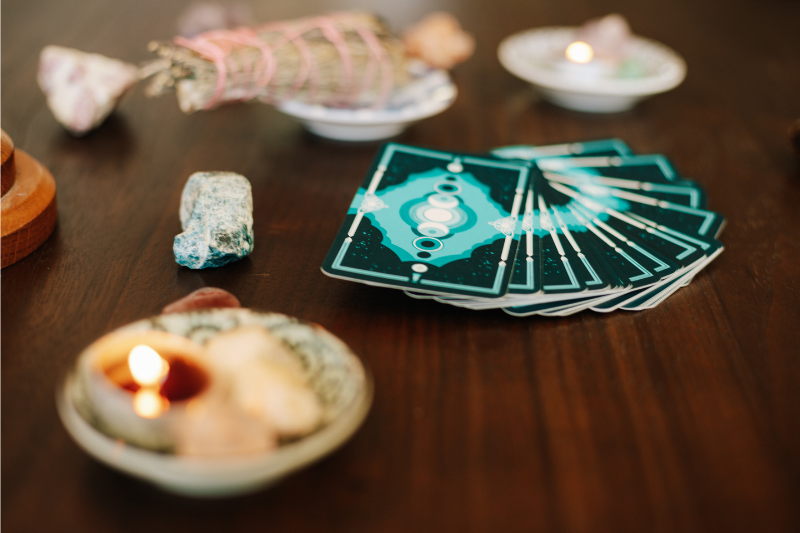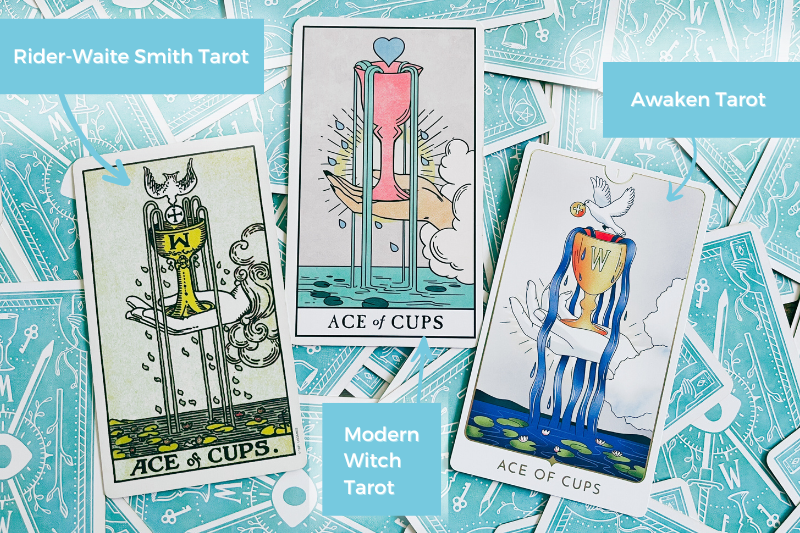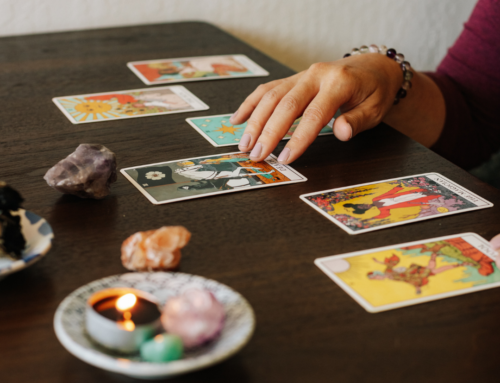How do I choose my first tarot deck?
Your guide to choosing a tarot deck for beginners
So you’re ready for your first tarot deck, aye? How exciting! With so many tarot decks out there, you may be wondering how to choose your first. A search for ‘tarot deck’ in google yields hundreds of possibilities. From Amazon to Etsy, you may have noticed — there are a heck-of-a-lot of decks out there. If you’re feeling confused, you’re not alone. How to choose a tarot deck is definitely a top frequently asked question from tarot learners.

Tips for choosing your first Tarot Deck
1) Pick a Tarot deck, and not an Oracle deck
You may have noticed at your local crystal shop that there are a lot of decks to choose from. Be aware that there are Tarot decks, and there are Oracle decks, which are different types of decks. If you’re interested in Tarot, ensure the box says that it is a tarot deck specifically.

Pictured: Starseed Oracle and Tarot of the Divine
What is the difference between a Tarot Deck and an Oracle Deck?
Tarot is an established system of cards containing 78 individual cards — 22 major arcana cards, 54 minor arcana cards which includes 4 suits. Each suit contains ace through ten, as well as court cards (Page, Knights, Queens, Kings). This system is universal when it comes to a tarot deck, just like how all playing cards contain the 4 suits, ace through 10 and jack, queen king, no matter who manufactured the deck, the tarot has a similar concept.
Oracle decks, on the other hand, do not adhere to the tarot system, and the creator of each oracle deck creates their own system or has no system at all. There’s no set amount of cards or suits in an Oracle deck. In a nutshell, Oracle decks are any ‘divination’ deck that is not a tarot deck. Oracle decks come in many themes, allowing the creator freedom to make the card whatever they’d like. For example, there are many amazing angel oracle decks, affirmation oracle decks, gratitude oracle decks, that are beautiful and useful — but, they’re not tarot decks.
For the most part, if it says “tarot” in the name and box, then, it’s a tarot deck. Please be advised that there are a few exceptions — the Osho Zen Tarot and the Psychic Tarot Oracle are not tarot decks in the traditional sense. Both of these adopt facets of the tarot, but are tangential to the tarot system. As an aside, I own and love both of these decks. Just be advised that if you’re looking to learn tarot, they will not match up to books or resources.
2) Pick a Tarot deck where the visuals resonate with you
All tarot reading is partially intuitive. There are books and resources that can give you the universal meanings and themes of a card, but the visuals and imagery can give you a lot of information on what the card is about. Each card is drawn or designed in a way that expresses the meaning of the card. And when looking for a first tarot deck, it can be helpful to use a deck that ‘speaks’ to you through its imagery, style and design.
Look through the cards of a variety of decks that appeal to you and ask yourself if you feel like you may know what the card is about. Does the deck use symbology you resonate with? Do you feel a connection with the cards?
There are so many decks out there and each of them are going to appeal to different people. Even as a professional Tarot reader, there are decks that I don’t resonate with and have a hard time gleaning information from. For example, The Tarot of Mystical Moments and the True Heart Intuitive Tarot are two decks that I really connect with. I look at the images and I instantly know what the card wants to say. On the other hand, the Wild Unknown Tarot is a very popular deck, but I can’t connect with it. The beauty of different decks is they appeal to different people. Find one that speaks to you.

Pictured: True Heart Intuitive Tarot and Tarot of Mystical Moments
3) When in doubt, use the Rider-Waite Smith Tarot Deck
A safe bet for tarot learners is the classic Rider-Waite Smith tarot deck. Rider-Waite Smith is the original standard system for what we now call tarot. Published in the early 20th century by the Rider company, commissioned by academic and mystic, A.E. Waite and illustrated by Pamela Colman Smith, the Rider-Waite Smith Tarot deck is the OG.
Because of this, Rider-Waite Smith Tarot is a great deck for beginners because most Tarot books and resources base the descriptions of the imagery and meanings on Rider-Waite Smith’s depictions. Many tarot artists have taken creative liberties on how to illustrate the meanings of the cards, and so even if there is a universal meaning, the imagery may not match up.

Pictured: Rider-Waite Smith Tarot
I started with the Rider-Waite Smith over a decade ago, which was helpful to me because I was a very analytical person who was not very attuned to symbology. Having books explain to me how an image represented something helped open me up to how symbology works. Because of this, I always recommend Rider-Waite Smith Tarot to learners, especially those who tend to intellectualize over relying on their feelings.
Modern Rider-Waite Smith Alternatives
If you’re not a fan of the classic stylings of Rider-Waite Smith, there are some beautiful modernized versions of the Rider Waite Smith Tarot that may be more appealing, such as the Modern Witch Tarot and Awaken Tarot. The imagery of both of these decks resemble the original, but with a more updated twist. Using these decks, the imagery is close enough for following the explanations in Tarot books and resources, but perhaps more aesthetically appealing for our contemporary senses.

Pictured: Rider-Waite Smith Tarot, Modern Witch Tarot, Awaken Tarot
A note about Rider-Waite Tarot vs Rider-Waite Smith Tarot
When you go to buy this classic deck, you may notice it’s called Rider-Waite Tarot. Both of these decks are the same exact decks. As a feminist in the tarot community, we try to call this classic deck Rider Waite Smith Tarot to include illustrator, Pamela Colman Smith included as she was left out of the credits in the original deck, even though it is her illustration that has been such a huge impact and influence on what Tarot is today, she didn’t get the credit she deserved. In honor of Pamela Colman Smith, I refer to the deck with her name included.
4) Don’t over analyze it, go with your intuition
And lastly, there’s no need to over-analyze! Use your gut when choosing a deck. Maybe you’re at the crystal shop and you’re feeling good vibes from a deck — trust your intuition! You can’t really go wrong. Just as Lao Tzu says “When the student is ready, the teacher will appear”, the same can be said about tarot. If you feel an urge to start learning Tarot, get your first deck and start pulling cards.

